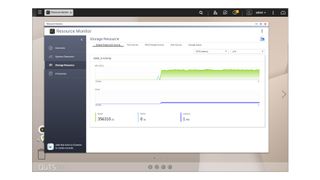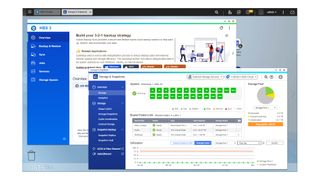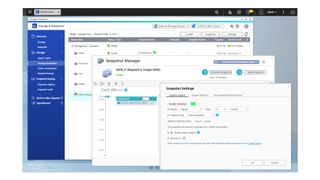IT Pro Verdict
Pros
- +
Excellent value
- +
24 U.2 NVMe SSD bays
- +
AMD EPYC Gen 2 CPU
- +
High DDR4 memory capacity
- +
Four 25GbE ports
- +
Top performance
- +
Great data integrity features
Cons
- -
Heavy workloads can ramp up PSU fans
Pure NVMe all-flash arrays (AFAs) are the only way to go for the best storage performance but most blue-chip solutions come with very high price tags. As it moves further into enterprise territory, Qnap aims to rock the boat with an NVMe SSD appliance that delivers a mighty hardware package at a very tempting price.
Stepping up as Qnap’s flagship enterprise-class AFA, the provocatively named TS-h2490FU not only supports up to 24 hot-plug U.2 NVMe SSDs but has AMD EPYC Gen2 power at its heart. On review, we have the high-end TS-h2490FU-7302P-128G which sports a 16-core 3.0GHz EPYC 7302P CPU teamed up with 128GB of DDR4 memory.
The TS-h2490FU is yet another addition to Qnap’s burgeoning QuTS hero stable and runs its new 128-bit ZFS-based OS. Data integrity is a key focus, and the OS supports near unlimited NAS and IP SAN snapshots, data deduplication, compression, fast replication to remote appliances and transparent self-healing of data corruption using end-to-end checksums.
This is impressive stuff for an NVMe AFA with a starting price that’s a shade over eight grand, but Qnap also throws in a couple of its dual-port SmartNIC 25GbE PCI-E adapters for good measure. Based on Mellanox ConnectX-4 Lx controllers, these 25/10GbE PCI-E Gen 3 cards have dual SFP28 connectors and support DAC (direct attach cable) or fibre connections and 10GbE SFP+ transceivers.
Qnap TS-h2490FU QuTS hero edition review: Hardware features
This 2U appliance is of sturdy construction and along with a steel rack chassis, uses solid metal drive carriers. For testing, we installed 24 Western Digital UltraStar DC SN640 U.2 NVMe SSDs – a good choice for the TS-h2490FU as these mixed use SSDs are designed for demanding workloads and offered in a range of capacities to suit different budgets.

The AMD EPYC 7302P CPU is designed for 1P platforms and brings a lot of features into play that you won’t find in many competing AFAs. The motherboard has sixteen standard DIMM slots and the base 128GB of memory can be upgraded to a massive 4TB using 256GB modules.
Memory speed is 3,200MHz and with 128 PCI-E lanes up for grabs, the EPYC CPU can dish out a dedicated 32Gbits/sec channel to each SSD. And, of course, the appliance’s five PCI-E slots are the faster Gen 4.0 variety.
Upgrades won’t take long as the motherboard and its cooling fan array are mounted on a single tray which is removed from the rear by releasing two thumbscrews and pulling its locking lever down. Power is handled by dual 1,100W hot-plug PSUs which are also easily accessed at the rear.
Qnap TS-h2490FU QuTS hero edition review: NAS and IP SAN services
During installation, the quick start wizard offers you the option of installing Qnap’s QTS or QuTS hero and for this review we’ll focus on the latter. Its web interface is virtually identical to QTS so is just as easy to navigate.
From the Storage & Snapshots app, we created a single RAID50 array using all 24 NVMe SSDs but QuTS hero also offers a couple of extra RAID options you won’t find in QTS. Triple mirroring allows you to have identical copies on three drives while RAID-TP (triple parity) expands on RAID6 and protects against three drive failures.

There are plenty of options to choose from during NAS share creation: you can enable thick or thin provisioning, encryption, compression, deduplication and WORM (write one read many). For WORM, you set a retention period in days, months or years and the Enterprise policy allows a protected folder to be deleted but stops anything in it from being individually modified or removed. The Compliance policy is tougher, as the only way to delete the folder is to remove the parent storage pool.
IP SANs are configured from the separate iSCSI & Fibre Channel app and when creating a LUN, you can apply thick or thin provisioning, deduplication and compression. For testing, we created thick-provisioned LUNs with compression enabled and left their synchronous I/O settings on default.
App availability for QuTS hero is extensive so you’ll find all of Qnap’s backup apps ready and waiting. These include HBS 3, Qsync Central and HybridMount plus Hyper Data Protector (HDP) which brings data protection to VMware and Hyper-V virtualized environments.
Qnap TS-h2490FU QuTS hero edition review: IP SAN performance

The smart buyer’s guide to flash
Find out whether flash storage is right for your business
To test IP SAN performance over 25GbE, we used a Broadberry Data Systems CyberServe AM2-B8252 rack server. This Tyan-based server was equipped with dual 32-core 2.4GHz AMD EPYC 7532 CPUs plus 1TB of DDR4 and running Windows Server 2019 to which we fitted two dual-port Qnap QXG-25G2SF-CX4 cards and connected them to the appliance using SFP28 DACs.
Performance for a single 25GbE connection is very impressive with Iometer reporting sequential read and write speeds for 512KB block sizes of 23.1Gbits/sec and 22Gbits/sec. I/O throughput is nothing to sniff at either with Iometer 4KB blocks returning random read and write rates of 157,100 IOPS and 130,100 IOPS.

Stepping up to a quad 25GbE MPIO connection to the iSCSI target saw Iometer sequential read and write speeds ramp up to 77Gbits/sec and 74.9Gbits/sec. I/O throughput for random read and write operations also increased nicely to 334,352 IOPS and 189,900 IOPS.
Businesses that plan on using the appliance’s NAS services won’t be disappointed either. With a share mapped to our test server over a single 25GbE connection, Iometer returned fast sequential read and write speeds for 512KB block sizes of 23.1Gbits/sec and 15.2Gbits/sec.
Qnap TS-h2490FU QuTS hero edition review: Verdict
Businesses that thought they couldn’t afford NVMe all-Flash storage arrays can think again as the TS-h2490FU delivers a powerful solution at a remarkably low price that even includes quad 25GbE ports. The AMD EPYC Gen 2 CPU and heap of DDR4 memory deliver great IP SAN performance while Qnap’s QuTS hero OS presents an impressive range of NAS and IP SAN storage services including enterprise-class data protection features.
Qnap TS-h2490FU specifications
| Chassis | 2U rack |
| CPU | 16-core 3.0GHz AMD EPYC 7302P |
| Memory | 128GB 3,200MHz DDR4 (max 4TB) |
| Storage | 24 x SFF U.2 NVMe SSD hot-plug bays |
| RAID | Qnap QuTS hero |
| Array support | RAID 0, 1, 5, 6, 10, 50, 60, Triple Parity, Triple Mirror |
| Expansion | 5 x PCI-E Gen 4.0 (3 free) |
| Network | 2 x 2.5GbE, 4 x 25GbE (2 x Qnap QXG-25G2SF-CX4) |
| Other ports | 2 x USB 3.2 Gen1 |
| Power | 2 x 1,100W hot-plug PSUs |
| Management | Web browser |
| Warranty | 3 years limited |
Dave is an IT consultant and freelance journalist specialising in hands-on reviews of computer networking products covering all market sectors from small businesses to enterprises. Founder of Binary Testing Ltd – the UK’s premier independent network testing laboratory - Dave has over 45 years of experience in the IT industry.
Dave has produced many thousands of in-depth business networking product reviews from his lab which have been reproduced globally. Writing for ITPro and its sister title, PC Pro, he covers all areas of business IT infrastructure, including servers, storage, network security, data protection, cloud, infrastructure and services.



